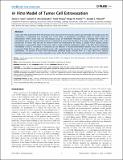In Vitro Model of Tumor Cell Extravasation
Author(s)
Jeon, Jessie S.; Zervantonakis, Ioannis; Chung, Seok; Kamm, Roger Dale
DownloadJeon-2013-In vitro model of tu.pdf (683.7Kb)
PUBLISHER_CC
Publisher with Creative Commons License
Creative Commons Attribution
Terms of use
Metadata
Show full item recordAbstract
Tumor cells that disseminate from the primary tumor and survive the vascular system can eventually extravasate across the endothelium to metastasize at a secondary site. In this study, we developed a microfluidic system to mimic tumor cell extravasation where cancer cells can transmigrate across an endothelial monolayer into a hydrogel that models the extracellular space. The experimental protocol is optimized to ensure the formation of an intact endothelium prior to the introduction of tumor cells and also to observe tumor cell extravasation by having a suitable tumor seeding density. Extravasation is observed for 38.8% of the tumor cells in contact with the endothelium within 1 day after their introduction. Permeability of the EC monolayer as measured by the diffusion of fluorescently-labeled dextran across the monolayer increased 3.8 fold 24 hours after introducing tumor cells, suggesting that the presence of tumor cells increases endothelial permeability. The percent of tumor cells extravasated remained nearly constant from1 to 3 days after tumor seeding, indicating extravasation in our system generally occurs within the first 24 hours of tumor cell contact with the endothelium.
Date issued
2013-02Department
Massachusetts Institute of Technology. Department of Biological Engineering; Massachusetts Institute of Technology. Department of Mechanical EngineeringJournal
PLoS ONE
Publisher
Public Library of Science
Citation
Jeon, Jessie S. et al. “In Vitro Model of Tumor Cell Extravasation.” Ed. Sotirios Koutsopoulos. PLoS ONE 8.2 (2013): e56910.
Version: Final published version
ISSN
1932-6203